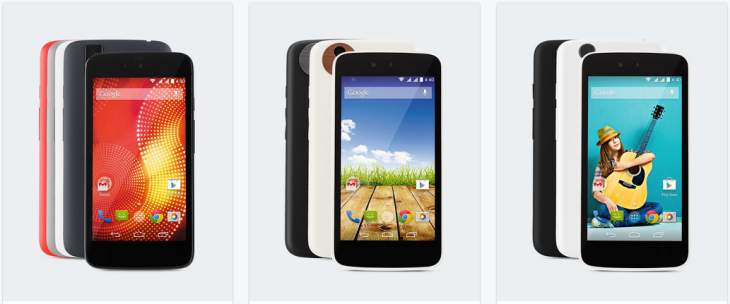Google has announced the first Android One devices — which are targeting the Indian market, starting at Rs 6,399/$105. Hardware partners for this first wave of affordable ‘Droids are Micromax, Karbonn, Spice and chipmaker MediaTek. It added that the Android One program will be expanded to Indonesia, the Philippines and South Asia (Bangladesh, Nepal, Pakistan, and Sri Lanka) by the end of the year, with more countries to follow in 2015.
Android’s global reach is already staggering but Google clearly isn’t content with owning the vast majority (circa 80%) of smartphone marketshare. With mobile maker Nokia out of the frame, now it’s been consumed by Microsoft, Google has evidently spotted a new not-so-niche market for Android to own — assuming it can persuade basic mobile phone buyers to opt for a smartphone instead.
Writing in a blog post today, Google’s Sundar Pichai, SVP, Android, Chrome & Apps, noted that some five billion-plus people don’t currently own a smartphone vs around 1.75 billion who do.
Google announced Android One, back in June at its I/O developer event. The program targets emerging markets with low cost Android devices. The aim is to improve the affordability and quality of budget Android smartphones by working with OEMs to identify components to use and pre-qualify suppliers for parts to ensure they work well together.
Why should Google care about raising quality standards at the budget end of Android? First and foremost to ensure the smooth running of Google apps like YouTube — which is how Mountain View monetizes Android. Driving affordability and low end quality should also help to further bulk out Android’s marketshare, and perhaps drive loyalty to the platform and discourage switching to another mobile OS at a later stage.
Apple has continued to shun the low cost smartphone market — which has allowed Android to own the space (and others, like Microsoft’s Windows Phone, to make a push for it). Google evidently wants to cement Android’s low end dominance, as well as seeking to improve its own reach into budget Androids — given that a large proportion of low cost devices running Android do not include Google’s Play store or have any of its apps pre-loaded, so aren’t currently contributing to Mountain View’s coffers.
If Google can build Android One as a budget brand it will be hoping to squeeze out the budget ‘Droids that lack any Google services. Although — for now — there’s still room for those devices to thrive at a sub-$100 price point.
Another potential driver here is Chinese Android startup Xiaomi, which has gained significant sales traction with smartphone hardware skinned with its own UI, including a mid-tier handset priced around $130. Google may view Xiaomi as a potential threat, if it can scale large enough that it’s able to replace Google services with its own alternatives. Android One may therefore be a defensive play to nip the threat of higher calibre low end Android competition in the bud.
To ensure a decent apps experience, the core hardware of Android One smartphones includes a quad-core chip, front and rear cameras, dual SIM card slots (an important feature for emerging markets where users often need to carefully manage carrier costs), a Micro SD card slot to expand storage, and enough battery capacity to survive a day’s use. On the software side, Android One devices are pledged to get the latest version of Google’s OS direct from Google — so these handsets will be among the first to get the forthcoming L release of Android, due later this year.
On the data cost front, Google has partnered with Indian carrier Airtel so that owners of Android One devices using the Airtel network will get Android software updates for free for the first six months. They will also be able to download up to 200MB per month worth of apps from Google Play without eating into their mobile data allowance.
Also today, Google said it’s expecting more hardware partners to join Android One, name-checking phone makers Acer, Alcatel Onetouch, Asus, HTC, Intex, Lava, Lenovo, Panasonic, Xolo, and chipmaker Qualcomm. “We expect to see even more high-quality, affordable devices with different screen sizes, colors, hardware configurations and customized software experiences,” it said.
